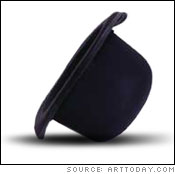Topping It Off with Hats
Updated February 21, 2017 | Factmonster Staff 

“Whatever is worn on the head is a sign of the mind beneath it.”—Alison Lurie, The Language of Clothes
Hat pins, which were once used to hold large straw hats in place, can also be used as weapons against muggers. |
- “A hat makes all the difference” was a U.S. advertising slogan used in 1930. For centuries, tradition linked hats with female status. Married women and mothers were required to cover their heads with hats as signs of respectability. Unmarried women went bare-headed. Headwear is also a sign of power, from the crowns worn by royalty to the feathered headdresses of tribal chiefs. Today, hats have become a fun topping. After a twenty-year lapse, they are back with a young, modern attitude.
- What's the difference between a bonnet, a cap, and a hat? The bonnet has no brim at the back and is usually tied under the chin. The cap fits closely to the head and doesn't have a brim, but it may have a visor. Hats vary in shape—they may or may not have a brim, but they are usually grander than caps.
- Hats were worn everywhere—indoors and out—by women in the eighteenth century. They even wore a hat called a baigneuse in the bathtub.
- The term “feather in your cap” came from the American Indian tradition of obtaining feathers for headdresses. Birds were captured, some feathers plucked, and the birds were released. Each feather represented an act of bravery.
- The fashion of decorating hats with feathers declined in the twentieth century because too many birds were being slaughtered for their feathers. This is similar to the slaughter of elephants in recent years for their ivory tusks.
Modern mad hatters
- Artist Salvador Dali designed a woman's hat in 1930 that was shaped like a shoe with the inverted heel pointing upward. He also designed what he called a “mad-cap,” which was shaped like a mountain peak.
- Designer Steven Jones created felt hats topped with a platter of fried eggs, sunnyside up. He also made hats that were simply metal colanders inverted on the wearer's head.
- Designer Anna Sui created teddy bear hats—whole bear heads that sit on the crown of the head.
Name that hat
These hats were well named, as their shapes show:
- Conversation hat (one side of the brim turned back and the other pulled forward)
- Beehive bonnet
- Pillbox
- Cloche (French for bell)
- Porkpie
 Arttoday.com
Arttoday.com- Turban
- Stocking cap
Fun hats of the '90s
- Velvet floppies
- Woolly grunge caps
- Funky felt fedoras
- Perky trilbies
- Cold-weather balaclavas
- Wholesome baseball caps worn backwards
- Dr. Seuss-style stocking caps
See also:
